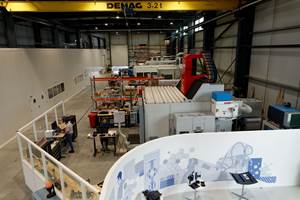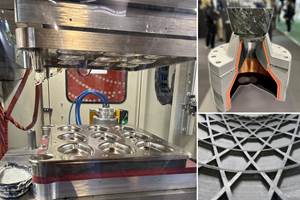UD thermoplastic composite formats cater to rigorous industry demands
CAMX 2025: Suprem SA exhibits its four principal UD composite formats, Suprem T, F, R and P, that can be manufactured using a wide selection of continuous fibers and thermoplastic matrices.
Share
Source | Suprem SA
Suprem SA (Yverdon-les-Bains, Switzerland) develops and manufactures continuous fiber-reinforced thermoplastic composites, consistently delivering materials designed to meet the rigorous demands of industries such as aerospace, defense, medical, energy and advanced manufacturing. The company’s comprehensive product portfolio features four principal unidirectional (UD) composite formats, each engineered for specialized processing and performance requirements:
- Suprem T (tapes). Ideal for automated tape placement and filament winding processes, these tapes offer optimal mechanical performance and consistent quality.
- Suprem F (Filaprem). Continuous fiber filaments that are optimized for 3D printing applications, enabling the production of strong, lightweight and complex parts with high thermal and chemical resistance.
- Suprem R (rods). Pultruded rods suitable for structural and mechanical applications.
- Suprem P (profiles). Tailor-made profiles featuring specific cross-section shapes to meet unique application needs in various industries.
These composite formats are manufactured using a wide selection of continuous fibers, including carbon (standard modulus, intermediate modulus, high modulus, ultra-high modulus), glass and aramid fibers, which are reinforced with high-performance thermoplastic matrices. The matrix selection includes TPI, PEEK, PEKK, LM-PAEK, PES, PPS, PA12 and fluoropolymers, providing adaptability in mechanical performance and processing capabilities.
Suprem’s production equipment, proprietary technology and process know-how ensure the consistent quality and reliability of its products. These materials are specifically engineered to support automated manufacturing techniques and in situ consolidation, enabling efficient production of complex, high-strength composite structures.
With 40 years of experience, the company is certified to ISO 9001 and ISO 13485 standards and complies with stringent qualification requirements for the medical, aerospace and ground transportation sectors. Suprem’s materials are widely used in applications such as medical implants, high-pressure hydrogen and compressed natural gas tanks, aerospace structural components, electric motor sleeves and lightweight systems for mobility and defense.
Related Content
-
Plant tour: Daher Shap’in TechCenter and composites production plant, Saint-Aignan-de-Grandlieu, France
Co-located R&D and production advance OOA thermosets, thermoplastics, welding, recycling and digital technologies for faster processing and certification of lighter, more sustainable composites.
-
JEC World 2024 highlights: Thermoplastic composites, CMC and novel processes
CW senior technical editor Ginger Gardiner discusses some of the developments and demonstrators shown at the industry’s largest composites exhibition and conference.
-
The potential for thermoplastic composite nacelles
Collins Aerospace draws on global team, decades of experience to demonstrate large, curved AFP and welded structures for the next generation of aircraft.
Related Content
Plant tour: Daher Shap’in TechCenter and composites production plant, Saint-Aignan-de-Grandlieu, France
Co-located R&D and production advance OOA thermosets, thermoplastics, welding, recycling and digital technologies for faster processing and certification of lighter, more sustainable composites.
Read MoreJEC World 2024 highlights: Thermoplastic composites, CMC and novel processes
CW senior technical editor Ginger Gardiner discusses some of the developments and demonstrators shown at the industry’s largest composites exhibition and conference.
Read MoreThe potential for thermoplastic composite nacelles
Collins Aerospace draws on global team, decades of experience to demonstrate large, curved AFP and welded structures for the next generation of aircraft.
Read MorePlant tour: Collins Aerospace, Riverside, Calif., U.S. and Almere, Netherlands
Composite Tier 1’s long history, acquisition of stamped parts pioneer Dutch Thermoplastic Components, advances roadmap for growth in thermoplastic composite parts.
Read MoreRead Next
Cutting 100 pounds, certification time for the X-59 nose cone
Swift Engineering used HyperX software to remove 100 pounds from 38-foot graphite/epoxy cored nose cone for X-59 supersonic aircraft.
Read MoreScaling up, optimizing the flax fiber composite camper
Greenlander’s Sherpa RV cab, which is largely constructed from flax fiber/bio-epoxy sandwich panels, nears commercial production readiness and next-generation scale-up.
Read MoreNext-gen fan blades: Hybrid twin RTM, printed sensors, laser shock disassembly
MORPHO project demonstrates blade with 20% faster RTM cure cycle, uses AI-based monitoring for improved maintenance/life cycle management and proves laser shock disassembly for recycling.
Read More






